Charger Soshine H2
Soshine have made a V2 of this charger, it can be reconized on the 9V support
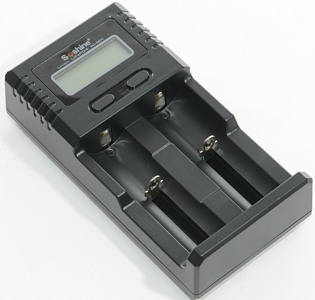
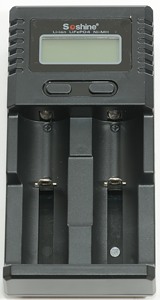
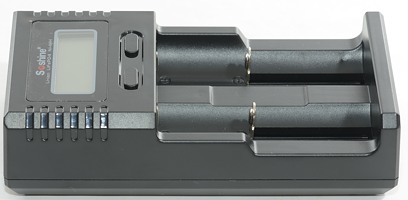
This charger looks like a two channel and improved version of the S7. The charger suppors 3 chemistries and up to 26650 cells, but only one charge current.
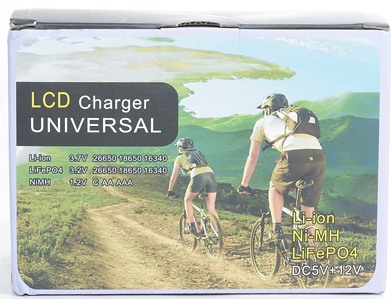
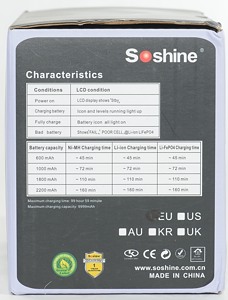
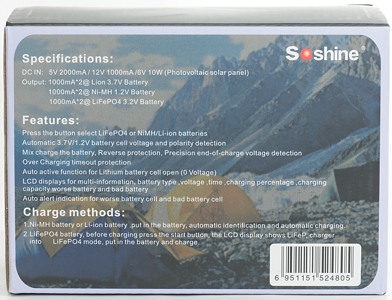
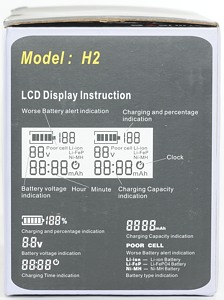
There is a lot of explanation on the box.
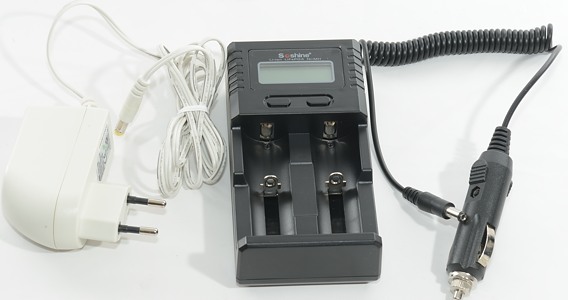
The contents of the box is only the charger and a power supply, i.e. the box is the manual.
I wonder about the white power supply to a black charger.

The charger has a small display and two buttons, one for each channel.
With no battery in the channel the button selects between ICR and IFR batteries.
With a battery in the channel the button toggles between used charge time and mAh.

Here is the full display, it was caught during self-test at power on.
The background led will turn off after a short time, pressing a button will turn it on again for some time.
Li-Ion is for ICR/IMR (LiCoO2/LiMn) batteries.
Li-FeP is for IFR (LiFePO4) batteries.

The charger can be supplied with 12 volt from the supplied power adapter or with 5 volt from usb, but a high power usb supply is needed, it can use up to 2A according to specifications.


The slider is very smooth and can handle from 31mm to more than 72 mm long batteries.


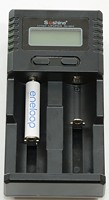
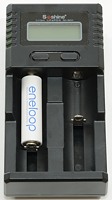
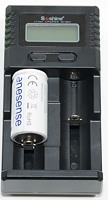
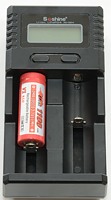
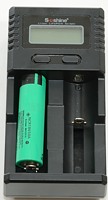
The charger can handle 70 mm long batteries including flat top cells.
Due to the "high" charge current, small LiIon batteries cannot be charged in it.
Measurements
- When not connected to power it will discharges with up to 6mA (LiIon).
- When power is connected with a full battery, the charger will charge, when the voltage drops slightly below termination voltage.
- Any voltage drop, reinsertion of battery or power cycling will restart charging.
- At 0 volt on the battery the charge current is 3.6mA (Display shows Stby).
- At about 0.6 volt the charger activates and starts testing for LiIon/NiMH, voltmeter shows -.-
- The voltmeter can show up to 2.4 volt in NiMH mode.
- At about 2.5 volt LiIon (LiIon/LiFePO4 settings has the same threshold) is selected, the voltmeter has a minimum value of 3.2 volt for LiOn.
- The voltmeter is limited to 4.2 volt maximum in LiIon mode.
- While charging it is possible to switch between time and mAh on the display
- The channels on the charger are independent, i.e. there are small differences between them.
I do not use my usual scale on the curves, because the charger overcharges I uses a higher maximum voltage
%20%231.png)
The charger uses a CC/CV charge curve with 800mA charge current, but check the voltage scale.
The charger goes up to 4.29 volt, that is not good.
%20%232.png)
The second channel goes above 4.4 volt, this is very bad.
Notice: The PA (Panasonic) batteries I am testing with are unprotected.
%20%231.png)
Something went completely wrong with this cell, the voltage jumps up and down and the up is above 4.7 volt!
It is probably because the overcharge protection in the battery trips, then the charge voltage goes up.
%20%231.png)
My 3400mA cell is also overcharged.
%20%231.png)
The old 16340 cell does never terminate, it has way to high leak current at 4.4 volt.
.png)
The charger is not heating the batteries much.

M1: 35,0°C, M2: 36,5°C, HS1: 46,4°C
But there is some heat just below the display.
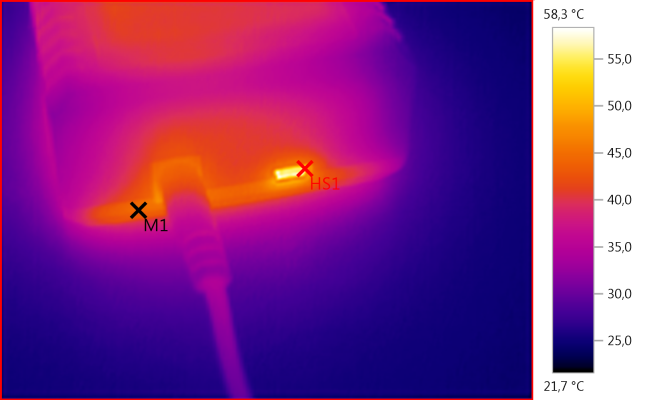
M1: 44,3°C, HS1: 58,3°C
And on the usb power connector.
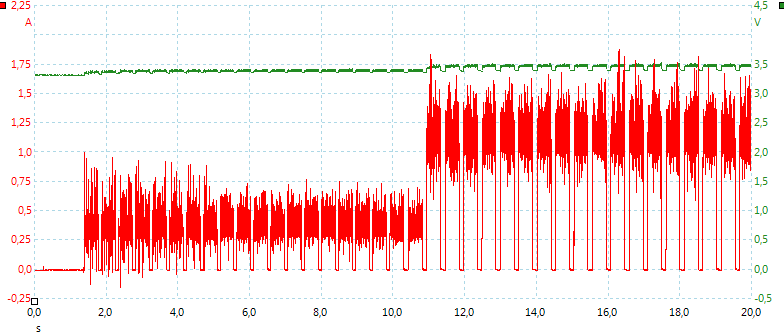
The charger runs a 10 second test cycle, before engaging full charge current.

The pulsing is probably for voltage measurement.
IFR LiFePO4
Pressing the button for a channel, without any battery in that channel, will select between ICR and IFR batteries. Default is ICR, i.e. 4.2 volt charge, pressing the button will select IFR, this is supposed to be 3.6 volt charge.
%20%231.png)
With IFR or LiFePO4 batteries, the charger is supposed to stop charging at about 3.6 volt. This charger does reduce the current, but not to zero. This means the voltage raises to above 4 volt, instead of dropping to 3.4 volt.
NiMH
%20%231.png)
With a 2000mAh eneloop, the charger only chargers 1000mAh, this is not very good.
%20%232.png)
On channel #2 I only got 600mAh.
.png)
Two eneloops, does not work better.
%20%231.png)
The eneloop XX does also get a partial charge.
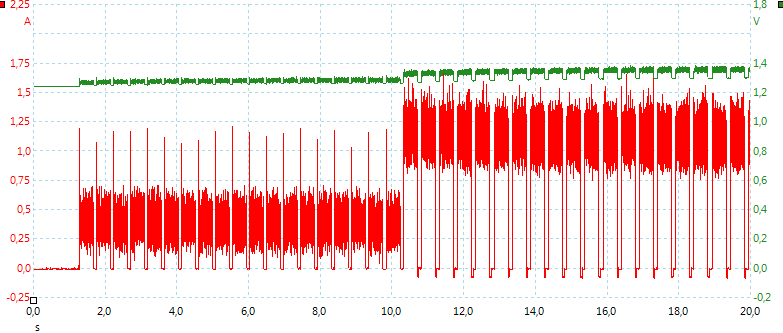
With NiMH it uses the same 10 second startup.
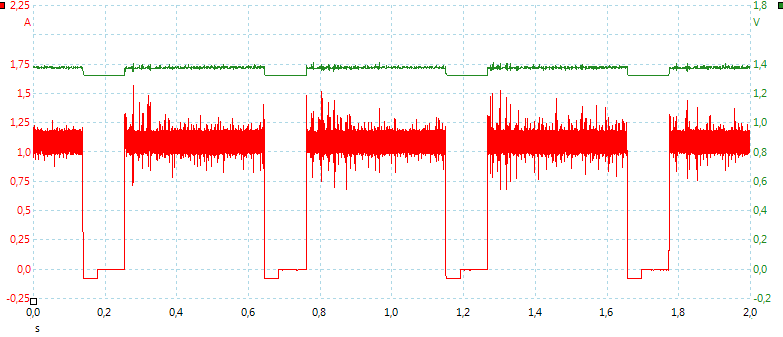
And pulsing while charging.
Testing with 2500 volt and 5000 volt between mains and low volt side, did not show any safety problems.
Conclusion
The charger did not charge one battery satisfactory during my test. It looks like the charger has 3 separate problems: To high charge voltage for ICR batteries, does not turn off on IFR batteries and partial charge on NiMH.
I cannot recommend this charger.
Notes
Here is an explanation on how I did the above charge curves: How do I test a charger




















%20%231.png)
%20%232.png)
%20%231.png)
%20%231.png)
%20%231.png)
.png)




%20%231.png)
%20%231.png)
%20%232.png)
.png)
%20%231.png)

